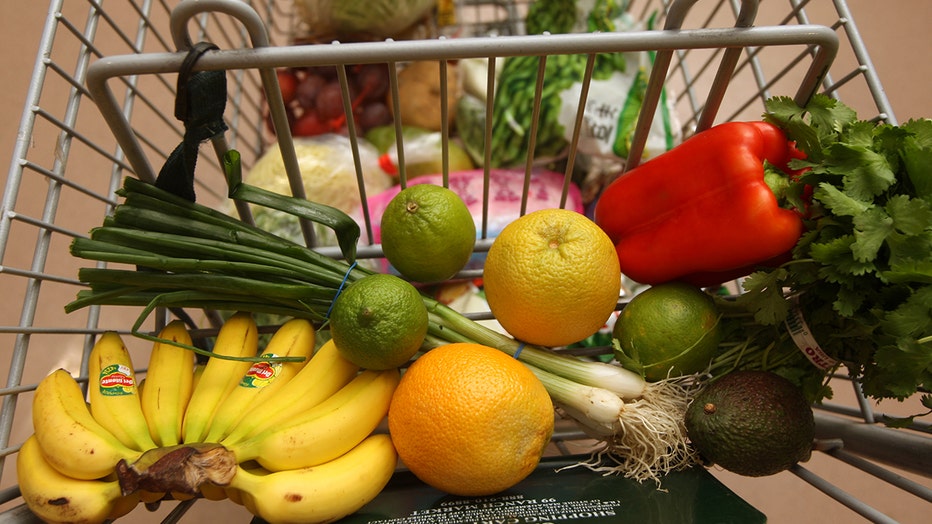Here’s what the typical grocery basket costs today – and it's higher than last year
Kale, strawberries, spinach top ‘Dirty Dozen’ list for pesticide contamination
Kale, the popular vegetable that serves as a staple in "clean eating" meal plans just made it onto the Environmental Wellness Group’s annual ranking of the most pesticide-ridden fruits and vegetables, otherwise known as the "Dirty Dozen."
A new LendingTree analysis reveals that the typical basket of groceries is higher than a year ago, underscoring ongoing inflation impacting Americans.
"Despite inflation cooling, it is still a key factor in driving up prices, with June’s inflation data showing a year-over-year increase of 3.0%." Natalie Kotlyar, a national practice leader of BDO's retail and consumer products industry group, told FOX Television Stations Monday.
LendingTree reviewed U.S. Department of Agriculture (USDA) and Bureau of Labor Statistics (BLS) data on the cost of hundreds of food items, including dairy, dry pantry items, eggs, fruits, meats, onions and potatoes and vegetables to help calculate the total cost of a typical basket of groceries for an American family.
The study, published Monday, found that prices on food in July were 3.1% higher than three months ago and 2% higher than a year ago.
Cost rises on groceries
The overall cost of the grocery basket was up 3.1% or $2.60 compared to three months earlier. This means the average grocery basket costs $86.18 compared to $83.58 last July.

Grocery shopping items from 99 Ranch Market in Richmond, California. (Credit: Craig Lee/San Francisco Chronicle via Getty Images)
The biggest increases were for large white A eggs, which were up 62.4% or $0.93 per dozen. Broccoli was also up 39.2% and russet potatoes were up 38.1%.
The overall cost of that same basket was also up 2.0% or $1.65 (from $84.53 to $86.18) compared to one year earlier. The biggest increases were on eggs, broccoli and bananas.
Biggest grocery price increases in one year
- Eggs, 71.6% increase
- Broccoli, 68.7% increase
- Bananas, 38.8% increase
- Butter, 19.1% increase
- Clementines, 14.6% increase
- Corn-Sweet, 9.6% increase
- Sugar, 9.5% increase
- Whole wheat bread loaf, 8.6% increase
- Green bell peppers, 8% increase
- Whole bagged fryer chicken, 6.5% increase
Grocery prices down from June
Despite this, the cost of groceries in July was 1.8% ($1.55) less than a month earlier, a small but welcome change after years of rising prices.
Carrots were down 42.4%, broccoli was down 28.6% and whole bagged fryer chicken was down 18.5%.
"Massive drops in the price of carrots, broccoli, whole chickens and zucchini (14.6%) helped offset spikes in the price of sweet corn, large white eggs, bananas and celery, all of which soared by at least 30.0%," LendingTree wrote.
The biggest price increases between June and July were on Chinese cabbage (up a substantial 228.2% or $1.28 per pound), chicken party wings (up 189.1%), organic cherry tomatoes (up 172%) and honeycrisp apples (up 112.4%).
In contrast, the five biggest price decreases between June and July were on rotisserie chicken leg quarters (down 69.3%), chayote (down 51.8%), Swiss chard (down 49.7%), apricots (down 47.8%) and d’anjou pears (down 45.5%).
How to save on groceries
"Life is expensive in 2024, and groceries are no exception. Even if inflation completely vanished tomorrow, that would still be the case. That makes it more important than ever that you do what you can to control your grocery store expenses," LendingTree wrote.
The company suggested shopping around, stating that where you buy can make a significant difference in the price you pay.
RELATED: How often should you go to the grocery store and how much to spend?
"If you don’t at least take the time to consider other stores, you’re doing yourself a disservice," they said.
LendingTree also recommended leveraging credit card rewards. The right card, used wisely, can help you extend your grocery budget, they said.
They also suggested making lists – a simple action that can make a difference on your grocery bill. Going shopping with a list can make you less susceptible to impulse purchases, which can wreck a budget.
LendingTree also suggested searching for deals and discounts with online coupons or mobile apps that help you find bargains.
This story was reported from Los Angeles.

